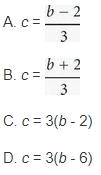6. Jeff tests how the total volume occupied by a fluid contained in a graduated cylinder changes when round marbles of various sizes are added. He found that the total volume occupied by the fluid, V, in cubic centimeters, can be found using the equation below, where x equals the number of identical marbles Jeff added, one at a time, to the cylinder, and r is the radius of one of the marbles. \( V=24π+x(\frac{4}{3}πr³) \). If the volume of the graduated cylinder is 96π cubic centimeters, then, what is the maximum number of marbles with a radius of 3 centimeters that Jeff can add without the volume of the fluid exceeding that of the graduated cylinder?
A. 1
B. 2
C. 3
D. 4
7. If b is two more than one-third of c, which of the following expresses the value of c in terms of b ?

8. The rotation rate of a mixing blade, in rotations per second, slows as a liquid is being added to the mixer. The blade rotates at 1,000 rotations per second when the mixer is empty. The rate at which the blade slows is four rotations per second less than three times the square of the height of the liquid. If h is the height of liquid in the mixer, which of the following represents R(h), the rate of rotation?
A. 4 – 9h²
B. 1,000 – (4 – 3h)
C. 1,000 – (9h – 4)
D. 1,000 – (3h² – 4)
9. A dental hygiene company is creating a new 24-ounce tube of toothpaste by combining its most popular toothpastes, Cavity Crusher and Bad Breath Obliterator. Cavity Crusher contains 0.25% of sodium fluoride as its active ingredient, and Bad Breath Obliterator contains 0.30% of triclosan as its active ingredient for a total of 0.069 ounces of active ingredients in both toothpastes. Solving which of the following systems of equations yields the number of ounces of Cavity Crusher, c, and the number of ounces of Bad Breath Obliterator, b, that are in the new toothpaste?
A. c + b = 0.069
0.25c + 0.3b = 24
B. c + b = 24
0.0025c + 0.003b = 0.069
C. c + b = 24
0.025c + 0.03b = 0.069
D. c + b = 24
0.25c + 0.3b = 0.069
10. Which of the following is a possible equation for a circle that is tangent to both the x-axis and the line x = 4 ?
A. (x + 2)² + (y + 2)² = 4
B. (x + 2)² + (y – 2)² = 4
C. (x – 2)² + (y + 4)² = 4
D. (x – 6)² + (y – 2)² = 4